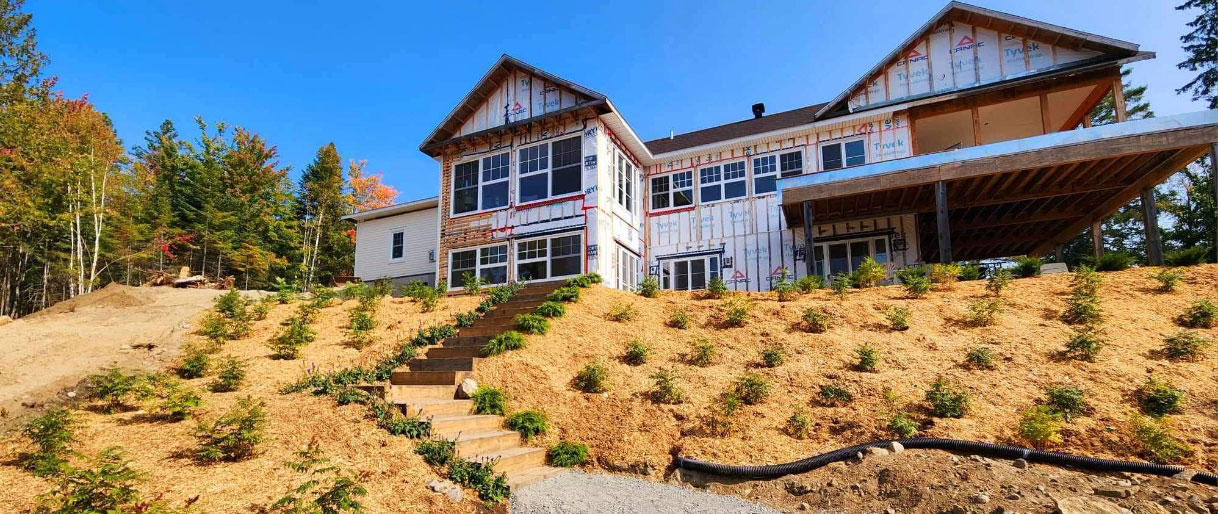At Canopée Développement, sustainable construction isn’t just a concept, it’s a mission that’s at the heart of everything we do. We firmly believe that the future of construction lies in environmentally-friendly practices, aimed at reducing the ecological footprint while offering healthy, innovative living spaces. With proven methods and a long-term vision, we’re helping to build a greener future.
1. Sustainable and Ecological Materials
One of Canopée Développement’s first commitments is the choice of materials. We use sustainable materials, often sourced locally, to minimize the carbon footprint of transportation. What’s more, these materials are selected for their low environmental impact throughout their life cycle, from extraction to recycling. Among the materials we favor are FSC-certified wood, which guarantees sustainable forest management, and natural insulants such as hemp wool and cork. These choices enable us to design buildings that are not only environmentally friendly, but also healthy for their occupants.
2. Efficient Energy Management
Reducing energy consumption is a central pillar of Canopée Développement’s ecological practices. Our projects are designed to optimize the energy efficiency of buildings. This includes the installation of high-performance insulation systems, the use of high-efficiency heating appliances and the integration of renewable energies such as solar panels. In addition, we favor passive solutions, such as optimal building orientation to maximize natural lighting and limit heating and cooling requirements. These practices not only reduce the carbon footprint of buildings, but also cut energy bills for occupants.
3. Responsible Water Management
Water is a precious resource, and at Canopée Développement we are committed to managing it responsibly. Our buildings incorporate rainwater recovery systems, water-saving irrigation systems for green spaces and low-consumption sanitary installations. We also take care to manage wastewater efficiently, using ecological treatment systems that limit its impact on the environment. These practices guarantee reduced consumption of natural resources and help preserve local ecosystems.
4. Waste Reduction and Management
Waste management is another cornerstone of our sustainable approach. On Canopée Développement worksites, we implement waste reduction policies, encouraging the recycling and reuse of materials. Our teams take care to limit waste and sort waste rigorously. What’s more, we work with local partners to recycle unused materials such as wood, metal and glass, thereby limiting the environmental impact of our buildings.
5. Biodiversity and Landscaping
At Canopée Développement, we believe that every construction project should respect and promote biodiversity. That’s why we incorporate green spaces and green roofs into our designs. These elements promote urban biodiversity while improving air quality and regulating building temperature. What’s more, our landscaping is designed with local species adapted to the climate, reducing water and maintenance requirements. We take care to preserve existing ecosystems, minimizing the impact of our worksites on local flora and fauna.
6. Community Engagement and Certifications
Finally, Canopée Développement is actively involved with local communities and promotes partnerships with sustainable development players. We work to obtain the most stringent green certifications, such as LEED or BREEAM, to ensure that our projects comply with the strictest environmental standards. These certifications testify to our long-term commitment to sustainable, ethical and responsible construction. They also enable future occupants to benefit from environmentally-friendly living spaces while enhancing the value of their real estate assets.
Conclusion
Sustainable construction is not just a choice at Canopée Développement, it’s a responsibility. By integrating ecological practices into every stage of our projects, we are helping to create a more environmentally friendly future. Whether through the use of sustainable materials, energy efficiency or responsible resource management, we do everything we can to offer buildings that combine innovation, well-being and respect for the planet.

